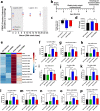Inhibiting tau-induced elevated nSMase2 activity and ceramides is therapeutic in an Alzheimer's disease mouse model
- PMID: 38049923
- PMCID: PMC10694940
- DOI: 10.1186/s40035-023-00383-9
Inhibiting tau-induced elevated nSMase2 activity and ceramides is therapeutic in an Alzheimer's disease mouse model
Abstract
Background: Cognitive decline in Alzheimer's disease (AD) is associated with hyperphosphorylated tau (pTau) propagation between neurons along synaptically connected networks, in part via extracellular vesicles (EVs). EV biogenesis is triggered by ceramide enrichment at the plasma membrane from neutral sphingomyelinase2 (nSMase2)-mediated cleavage of sphingomyelin. We report, for the first time, that human tau expression elevates brain ceramides and nSMase2 activity.
Methods: To determine the therapeutic benefit of inhibiting this elevation, we evaluated PDDC, the first potent, selective, orally bioavailable, and brain-penetrable nSMase2 inhibitor in the transgenic PS19 AD mouse model. Additionally, we directly evaluated the effect of PDDC on tau propagation in a mouse model where an adeno-associated virus (AAV) encoding P301L/S320F double mutant human tau was stereotaxically-injected unilaterally into the hippocampus. The contralateral transfer of the double mutant human tau to the dentate gyrus was monitored. We examined ceramide levels, histopathological changes, and pTau content within EVs isolated from the mouse plasma.
Results: Similar to human AD, the PS19 mice exhibited increased brain ceramide levels and nSMase2 activity; both were completely normalized by PDDC treatment. The PS19 mice also exhibited elevated tau immunostaining, thinning of hippocampal neuronal cell layers, increased mossy fiber synaptophysin immunostaining, and glial activation, all of which were pathologic features of human AD. PDDC treatment reduced these changes. The plasma of PDDC-treated PS19 mice had reduced levels of neuronal- and microglial-derived EVs, the former carrying lower pTau levels, compared to untreated mice. In the tau propagation model, PDDC normalized the tau-induced increase in brain ceramides and significantly reduced the amount of tau propagation to the contralateral side.
Conclusions: PDDC is a first-in-class therapeutic candidate that normalizes elevated brain ceramides and nSMase2 activity, leading to the slowing of tau spread in AD mice.
Keywords: Alzheimer’s disease; Ceramide; Extracellular vesicles; Neutral sphingomyelinase 2; Tau.
© 2023. The Author(s).
Conflict of interest statement
CT, AGT, RR, NJH and BSS are listed as inventors in patent applications filed by Johns Hopkins Technology Ventures covering novel compositions and utilities of nSMase2 inhibitors, including PDDC. This arrangement has been reviewed and approved by the Johns Hopkins University in accordance with its conflict-of-interest policies. Other authors declare that no conflict of interest exist.
Figures








Update of
-
Inhibiting tau-induced elevated nSMase2 activity and ceramides is therapeutic in murine Alzheimer's disease.Res Sq [Preprint]. 2023 Jul 18:rs.3.rs-3131295. doi: 10.21203/rs.3.rs-3131295/v1. Res Sq. 2023. Update in: Transl Neurodegener. 2023 Dec 4;12(1):56. doi: 10.1186/s40035-023-00383-9. PMID: 37502930 Free PMC article. Updated. Preprint.
References
-
- Avgerinos KI, Ferrucci L, Kapogiannis D. Effects of monoclonal antibodies against amyloid-beta on clinical and biomarker outcomes and adverse event risks: a systematic review and meta-analysis of phase III RCTs in Alzheimer's disease. Ageing Res Rev. 2021;68:101339. doi: 10.1016/j.arr.2021.101339. - DOI - PMC - PubMed
MeSH terms
Substances
Grants and funding
LinkOut - more resources
Full Text Sources
Medical

